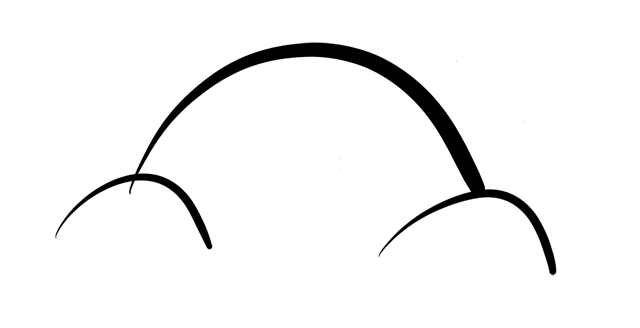-
This is good – although it's _another_ reminder that my notebooks are not as legible as they once were.
-
Using Sketchup as your modeller, and a few other neat things. Bookmarked for reference.
-
"It took awhile to climb this mountain, 14 months actually. So to “show our work”, we’re posting around 45,000 words that mark the trail we took. It’s not every text, skype call or even every email in our big 500+ email thread. But it’s the important stuff, and a lot of it was important to getting Threes out in the world." I'd pay for this as a book, to be honest. Really excellent stuff.
-
"When my brother and I wanted a new toy, we cannibalized whatever we’d made before, which had been made of all the things we’d ever made before that. So of all those years of guns and starships, I have only that Wrightian feeling for form in the fingertips — and the sound, somewhere between rustling and clinking, of a thousand plastic pieces tumbling from an overturned bucket into a disorderly pile, rippling away from a seeking hand." As Paul M pointed out, that sound is very, very visceral for many of us. This is a lovely article about what Lego does to the head.
-
Great interview on the end titles for the Lego Movie, which, unlike the rest of the film, were actual stop motion. From designing in Lego Digital Design, through digital previz, and into manufacture, lots of details shared and cunning insight; motion controller stereoscopic stop motion isn't easy, you know. Very much symptomatic of all the detail throughout the film.
-
"Today I want to talk about these moments when the future falls in our laps, with no warning or consideration about whether we're ready to confront it." This is a great, great talk from Maciej, on the histories of technology, and how culture interferes with work, and how 20th century history complicated most things it touched. Also: the rant in the middle is good. I think this might be my favourite Maciej talk I've read or seen.
First Read / Second Read
30 January 2014
Drinking a beer having finished playing records at the last Wild Rumpus, I got talking to Cara. She asked me a difficult question. Later, she would write this up in her embedded look at the London indie scene, and make me sound more profound than I think I did. It’s a very good article; you should go and read it.
Still, with the advantage of time, I wanted to write down the two things I said to her for posterity, because they’re worth bearing in mind, and I want to remember them for myself.
Disclaimer: like so many of the so-called “smart things” I’ve ever said, this is basically a Matt Jones paraphrase.
Jones once explained, talking in the studio one day, a theory that had come from car design: First Read / Second Read.
What I remember him saying:
to design a really memorable car, you need a strong first read. A really strong first read. That’s the single shape, barely a single line that you remember at a glance. Like this:

You know what car I’m showing you already.
But: it’s not enough to have a strong first read. Then, when you’re closer, or double-taking, you need a strong second-read: that detail echoed, firming up the original shape, but making the coherence clear:

And then, on the third read, once you’ve encompassed the detail therein, you still need something to satisfy the eye: details to take in, subtleties and shapes.

The Beetle is an obvious way of showing this, but it really works: it’s not just that strong first read that makes the Beetle so beautiful; it’s the strong first, second, and third reads all co-existing at once that make it work quite so well. Detail that you never get sucked into won’t work; a striking first impression that goes nowhere won’t work.
And Jones, astute as ever, would point out this applied to many forms of design: often, getting the strong first read would be hard, sucking someone into the detail we’d made – but sometimes, you’d also have to focus on backing up that first read with detail.
(Fashion does this well, for instance – the emphasis on understanding form often coming from a silhouette, and then the eye taking in more than just the outline.)
I think the best games do this. Cara mentioned the FPS example, but to be frank, it applies to anything: card games; beat-em-ups; sports; real-time-strategy. The first read has to be clear, broad: grokkable, and also aesthetically enticing. Once enticed, you need that detail to repeat, to be fractal, to be backed up by substance. And then, as you delve deeper, into expertise and experience, there’s still depth to reward you, but it never clashes against that first read you had, the thing that sucked you in.
As I write that, I realise: it’s not so far from MDA. But I’m aware I can get a bit hardline about MDA, and actually, first/second/third read speaks to everything: that moment you discover depth in the aesthetics of a game that echoes the surface; or similarly, a first read of why a mechanic is fun (‘we’re all sharing the same resources, but have our own goals!‘).
I suppose the real point is: designing for depth is not about neglecting the surface. It’s about leading the player on that journey to expertise, satisfying them at all turns of the path. It’s no surprise my favourite beat-em-ups are both simple on the surface and the most beautiful. It’s no surprise my favourite card games have the simplest surface rules, but a deep path to expertise, usually based on inter-personal interactions – fakeouts, Yomi.
I used to say that I really liked the idea of being able to recognise a game at 20ft – you see someone with a phone on the Tube and you just know that they’re playing something different that far away. Is it through the aesthetic? Is it through how they interact? I don’t know – it doesn’t matter. What matters is that you can read it that far away. And then, you get closer, and you want to read more detail: not just clearer graphics, but also clearer interactions, clearer mechanics. We start to suck players in when they see a screen in a friend’s house and say “What’s that?” And that’s the real challenge, I reckon: designing that path in.
There’s another side to this question though.
The original question Cara asked me, standing in BL-NK, was “As a games designer, what do you want players to do?”
I thought for a bit, and said: well, follow the rules, of course. Play the game as intended, and enjoy it. Then, I realised that was the wrong answer. So I correct course.
Because what I’ve learned about some of the best games I’ve worked on, designed, or played, was that they design well for failure states. I’ve designed games that were fun if you played them right, but terrible if you didn’t get the rules.
They were not good games.
By contrast, games that are great if you play as the designer intended – but also great if you play them your way, if you get lost in the components and the systems and recompose them in some other form that still excites and entertains you: well, that’s good too.
Good games are resilient. This is why people sometimes have house rules for Mario Kart, for Catan. This is why people play in large sandbox games without completing missions. This is why RPG GMs will throw the rulebook out to tell a better story.
So I said that, first of all – that I’d like to design for resilience.
And then I added an addendum: whilst it’d be good if games were resilient to misinterpretation, to being played with, the best games afford that but you rarely go down that path, because they lead you on this great journey, from surface read to deep expertise (and frequently back out again, as you show a new friend the surface of a favourite game).
And I told a story about the Volkswagen Beetle.
-
"At a coffee shop near his office, Kazemi says he feels about his bots the way he imagines parents must feel about their children. “I’ve created these things, and they’re kind of separate from me now, and so I do feel kind of proud of them,” he says. “Every morning I wake up and I look at the last two hours of TwoHeadlines, and it just gets me every time.”" Yup. That.
-
"Under the [Do What You Love] credo, labor that is done out of motives or needs other than love (which is, in fact, most labor) is not only demeaned but erased. As in Jobs’ Stanford speech, unlovable but socially necessary work is banished from the spectrum of consciousness altogether." This is astute and good, on what happens when work is divided into either "things you love anyway" or "labor that we will banish from view" – and the enabling forces that let someone Do What They Love.
-
"…we though it would be it would be interesting to ask the students to deconstruct a logic prevalent in the games industry (F2P) and to then apply that logic to a real-world system (in this case, a London transport) service." I loved this when Kars first told me about the brief, and I love seeing it again now.
-
"We learned that being first is important, but should not be the only factor when determining the viability of a project. If you have an evolved approach to a preexisting concept, you are likely doing something original and the results have a good chance of being meaningful." So, in one sense, it's another physical mirror. But: I like this point, that sometimes, you have to do a thing for yourself to learn about it. And by learning about it, you might ultimately differentiate your own work. As long as you don't claim you were first, there is no shame in doing what other people do. How else do you learn things? Not by other people yelling "OLD!" at you, that's for sure.
-
"Gifsicle is a command-line tool for creating, editing, and getting information about GIF images and animations." Handy.
-
"These three frameworks — objects as portals, objects as subjects, and objects as oracles — propose distinct (yet related) structures for thinking about how connected objects might begin to contain their own narratives, seek their own history, develop their own perspectives, and become storytellers in a multitude of ways." Nice article about the various perspectives on Connected Objects (which namechecks Hello Lamp Post).
-
"I learned a hell of a lot designing and building Dopplr. I still stand by a lot of the principles that we as a team tried to follow." So did we all, Matt; it's still a model in the background of my head for things I work on.
-
Ben on postboxes as boundary objects – with a nice map from Hello Lamp Post, indicating how the boxes were talked to, and suitable name-checks to The Crying of Lot 49.